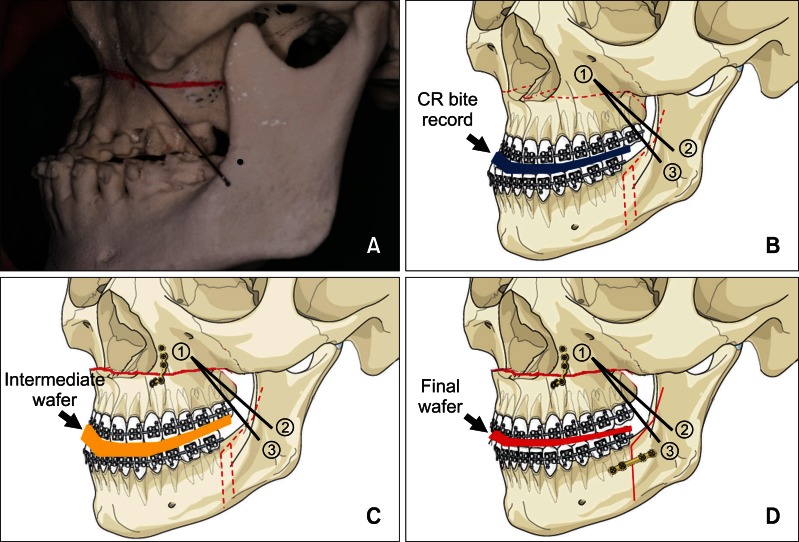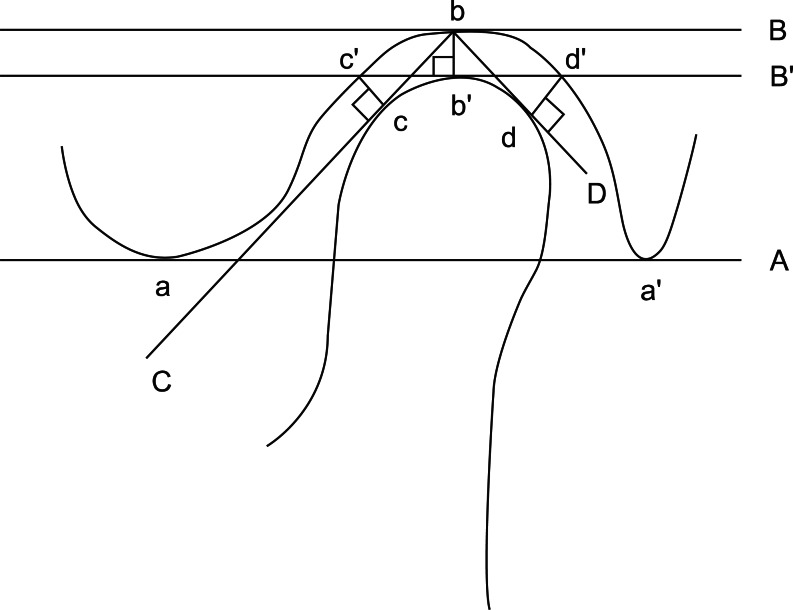Korean J Orthod.
2013 Apr;43(2):74-82. 10.4041/kjod.2013.43.2.74.
Condylar repositioning using centric relation bite in bimaxillary surgery
- Affiliations
-
- 1Division of Oral and Maxillofacial Surgery, Department of Dentistry, Hallym University College of Medicine, Anyang, Korea. face@hallym.or.kr
- KMID: 1975145
- DOI: http://doi.org/10.4041/kjod.2013.43.2.74
Abstract
OBJECTIVE
The purpose of this study was to evaluate displacement of the mandibular condyle after orthognathic surgery using a condylar-repositioning device.
METHODS
The patient group comprised 20 adults who underwent bimaxillary surgery between August 2008 and July 2011. The degree of condylar displacement was measured by pre- and postoperative tomographic analysis using centric relation bite and a wire during surgery. A survey assessing temporomandibular joint (TMJ) sound, pain, and locking was performed. The 20 tomographs and surveys were analyzed using the Wilcoxon signed-rank test and McNemar's test, respectively.
RESULTS
No significant changes were observed in the anterior, superior, or posterior joint space of the TMJ (p > 0.05). In addition, no significant change was observed in TMJ sound (p > 0.05). However, TMJ pain and locking both decreased significantly after surgery (p < 0.05).
CONCLUSIONS
Due to its simplicity, this method may be feasible and useful for repositioning condyles.
MeSH Terms
Figure
Reference
-
1. Epker BN, Wylie GA. Control of the condylar-proximal mandibular segments after sagittal split osteotomies to advance the mandible. Oral Surg Oral Med Oral Pathol. 1986; 62:613–617. PMID: 3467286.
Article2. Timmis DP, Aragon SB, Van Sickels JE. Masticatory dysfunction with rigid and nonrigid osteosynthesis of sagittal split osteotomies. Oral Surg Oral Med Oral Pathol. 1986; 62:119–123. PMID: 3462606.
Article3. Leonard M. Preventing rotation of the proximal fragment in the sagittal ramus split operation. J Oral Surg. 1976; 34:942. PMID: 1067396.4. Bell WH, Proffit WR, White RP. Surgical correction of dentofacial deformities. 1980. Philadelphia: Saunders.5. Luhr HG, Kubein-Meesenburg D. Rigid skeletal fixation in maxillary osteotomies. Intraoperative control of condylar position. Clin Plast Surg. 1989; 16:157–163. PMID: 2924489.6. Luhr HG. The significance of condylar position using rigid fixation in orthognathic surgery. Clin Plast Surg. 1989; 16:147–156. PMID: 2924488.
Article7. Hiatt WR, Schelkun PM, Moore DL. Condylar positioning in orthognathic surgery. J Oral Maxillofac Surg. 1988; 46:1110–1112. PMID: 3193288.
Article8. Gateno J, Miloro M, Hendler BH, Horrow M. The use of ultrasound to determine the position of the mandibular condyle. J Oral Maxillofac Surg. 1993; 51:1081–1086. PMID: 8410446.
Article9. Bettega G, Cinquin P, Lebeau J, Raphaël B. Computer-assisted orthognathic surgery: clinical evaluation of a mandibular condyle repositioning system. J Oral Maxillofac Surg. 2002; 60:27–34. PMID: 11757002.
Article10. Bettega G, Dessenne V, Raphaël B, Cinquin P. Computer-assisted mandibular condyle positioning in orthognathic surgery. J Oral Maxillofac Surg. 1996; 54:553–558. PMID: 8632238.
Article11. Luhr HG. Pfeifer G, editor. Skelettverlagernde Operationen zur Harmonisierung des Gesichtsprofiles. Die Ästhetik von Form und Funktion in der Plastischen und Wiederherstellungschirurgie. 1985. Stuttgart: Springer.12. Helm G, Stepke MT. Maintenance of the preoperative condyle position in orthognathic surgery. J Craniomaxillofac Surg. 1997; 25:34–38. PMID: 9083399.
Article13. Heffez L, Marsik J, Bressman J. A simple means of maintaining the condyle-fossa relationship. J Oral Maxillofac Surg. 1987; 45:288–290. PMID: 3469374.
Article14. Raveh J, Vuillemin T, Lädrach K, Sutter F. New techniques for reproduction of the condyle relation and reduction of complications after sagittal ramus split osteotomy of the mandible. J Oral Maxillofac Surg. 1988; 46:751–757. PMID: 3166045.
Article15. Fujimura N, Nagura H. New appliance for repositioning the proximal segment during rigid fixation of the sagittal split ramus osteotomy. J Oral Maxillofac Surg. 1991; 49:1026–1027. PMID: 1886015.
Article16. Harada K, Okada Y, Nagura H, Enomoto S. A new repositioning system for the proximal segment in sagittal split ramus osteotomy of the mandible. Int J Oral Maxillofac Surg. 1994; 23:71–73. PMID: 8035053.
Article17. Landes CA. Proximal segment positioning in bilateral sagittal split osteotomy: intraoperative dynamic positioning and monitoring by sonography. J Oral Maxillofac Surg. 2004; 62:22–28. PMID: 14699544.
Article18. Will LA, Joondeph DR, Hohl TH, West RA. Condylar position following mandibular advancement: its relationship to relapse. J Oral Maxillofac Surg. 1984; 42:578–588. PMID: 6590809.
Article19. Jäger A, Kubein-Meesenburg D, Luhr HG. Longitudinal study of combined orthodontic and surgical treatment of Class II malocclusion with deep overbite. Int J Adult Orthodon Orthognath Surg. 1991; 6:29–38. PMID: 1940537.20. Boulétreau P, Bettega G, Breton P, Freidel M. Results of an evaluation of clinical practice in orthognathic surgery in France in 2002. Rev Stomatol Chir Maxillofac. 2003; 104:326–329. PMID: 14968095.21. Athanasiou AE, Mavreas D. Tomographic assessment of alterations of the temporomandibular joint after surgical correction of mandibular prognathism. Int J Adult Orthodon Orthognath Surg. 1991; 6:105–112. PMID: 1811029.22. Boucher L, Jacoby J. Posterior border movements of the human mandible. J Prosthet Dent. 1961; 11:836–841.
Article23. Zak MJ, Dolan EA, Angelillo JC, McGraw TA. No effect of neuromuscular blockade on the temporomandibular joint position during general anesthesia. Anesth Prog. 1992; 39:212–214. PMID: 7902683.24. Helkimo M, Ingervall B, Carlsson GE. Variation of retruded and muscular position of mandible under different recording conditions. Acta Odontol Scand. 1971; 29:423–437. PMID: 5289331.
Article25. McMillen LB. Border movements of the human mandible. J Prosthet Dent. 1972; 27:524–532. PMID: 4502089.
Article26. Politi M, Toro C, Costa F, Polini F, Robiony M. Intra operative awakening of the patient during orthognathic surgery: a method to prevent the condylar sag. J Oral Maxillofac Surg. 2007; 65:109–114. PMID: 17174773.27. Deng X, Wan Z, He SS, Wamalwa P, Chen S, Zhang ZY. The centric relation-maximum intercuspation discrepancy in adult angle's class II pretreatment patients. Hua Xi Kou Qiang Yi Xue Za Zhi. 2011; 29:48–52. PMID: 21427900.28. Afzal A, Shameem A. Comparison of condylar positions in centric relation and centric occlusion in pre-treatment malocclusion cases. J Coll Physicians Surg Pak. 2005; 15:620–623. PMID: 19810300.29. Bamber MA, Abang Z, Ng WF, Harris M, Linney A. The effect of posture and anesthesia on the occlusal relationship in orthognathic surgery. J Oral Maxillofac Surg. 1999; 57:1164–1172. PMID: 10513861.
Article30. Dawson PE. Temporomandibular joint pain-dysfunction problems can be solved. J Prosthet Dent. 1973; 29:100–112. PMID: 4508618.
Article31. Gilboe DB. Centric relation: functional anatomy. J Can Dent Assoc. 1983; 49:345–348. PMID: 6342723.32. Carlson CR, Okeson JP, Falace DA, Nitz AJ, Curran SL, Anderson D. Comparison of psychologic and physiologic functioning between patients with masticatory muscle pain and matched controls. J Orofac Pain. 1993; 7:15–22. PMID: 8467294.33. McCollum BB. The mandibular hinge axis and a method of locating it. J Prosthet Dent. 1960; 10:428–435.
Article34. Panula K, Somppi M, Finne K, Oikarinen K. Effects of orthognathic surgery on temporomandibular joint dysfunction. A controlled prospective 4-year follow-up study. Int J Oral Maxillofac Surg. 2000; 29:183–187. PMID: 10970079.
Article35. Westermark A, Shayeghi F, Thor A. Temporomandibular dysfunction in 1,516 patients before and after orthognathic surgery. Int J Adult Orthodon Orthognath Surg. 2001; 16:145–151. PMID: 11482293.36. De Clercq CA, Neyt LF, Mommaerts MY, Abeloos JS. Orthognathic surgery: patients' subjective findings with focus on the temporomandibular joint. J Craniomaxillofac Surg. 1998; 26:29–34. PMID: 9563592.
Article37. Wolford LM, Reiche-Fischel O, Mehra P. Changes in temporomandibular joint dysfunction after orthognathic surgery. J Oral Maxillofac Surg. 2003; 61:655–660. PMID: 12796870.
Article38. Costa F, Robiony M, Toro C, Sembronio S, Polini F, Politi M. Condylar positioning devices for orthognathic surgery: a literature review. Oral Surg Oral Med Oral Pathol Oral Radiol Endod. 2008; 106:179–190. PMID: 18417381.
Article39. Gerressen M, Stockbrink G, Smeets R, Riediger D, Ghassemi A. Skeletal stability following bilateral sagittal split osteotomy (BSSO) with and without condylar positioning device. J Oral Maxillofac Surg. 2007; 65:1297–1302. PMID: 17577492.
Article40. Béziat JL, Babic B, Ferreira S, Gleizal A. Justification for the mandibular-maxillary order in bimaxillary osteotomy. Rev Stomatol Chir Maxillofac. 2009; 110:323–326. PMID: 19939425.
- Full Text Links
- Actions
-
Cited
- CITED
-
- Close
- Share
- Similar articles
-
- The Effect of a Condylar Repositioning Plate on Condylar Position and Relapse in Two-Jaw Surgery
- The effect of occlusal splint therapy on condylar positional changes in malocclusion patients
- Relative position of mandibular condyle and comparison of reproducibility utilizing different centric relation record taking methods
- CLINICAL, RADIOGRAPHIC EVALUATIONS OF INTERNAL DERANGEMENT OF TEMPOROMANDIBULAR JOINT TREATED BY CENTRIC RELATION AND ANTERIOR REPOSITIONING SPLINTS
- Conserving the centric relation position of condylar head with mini-Hoffmann sets in vertical ramus osteotomy




